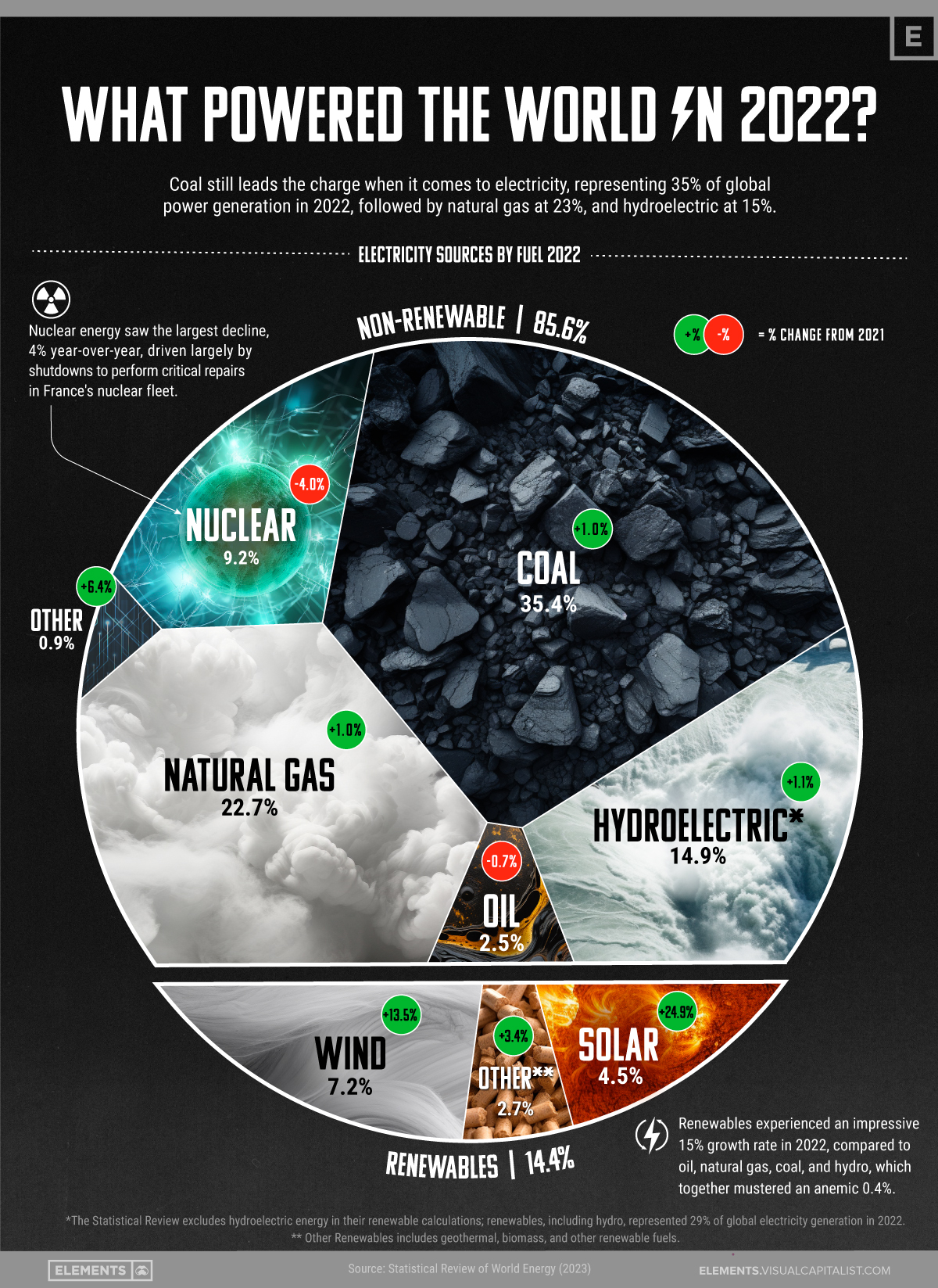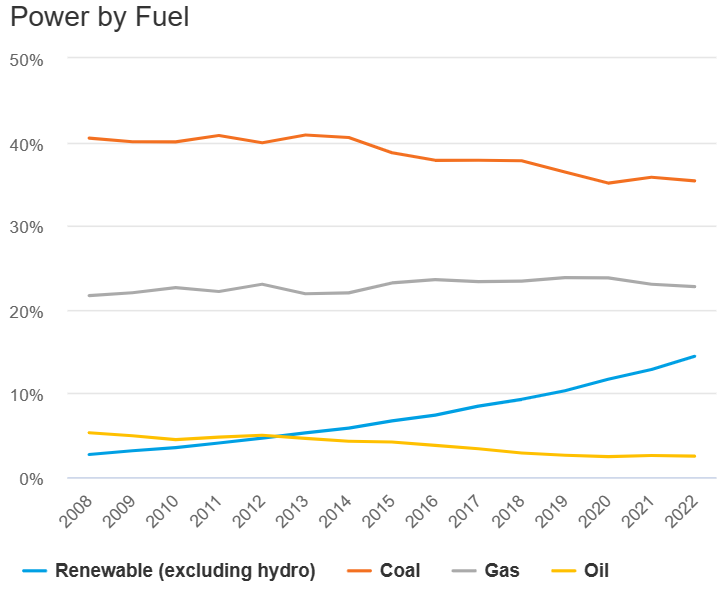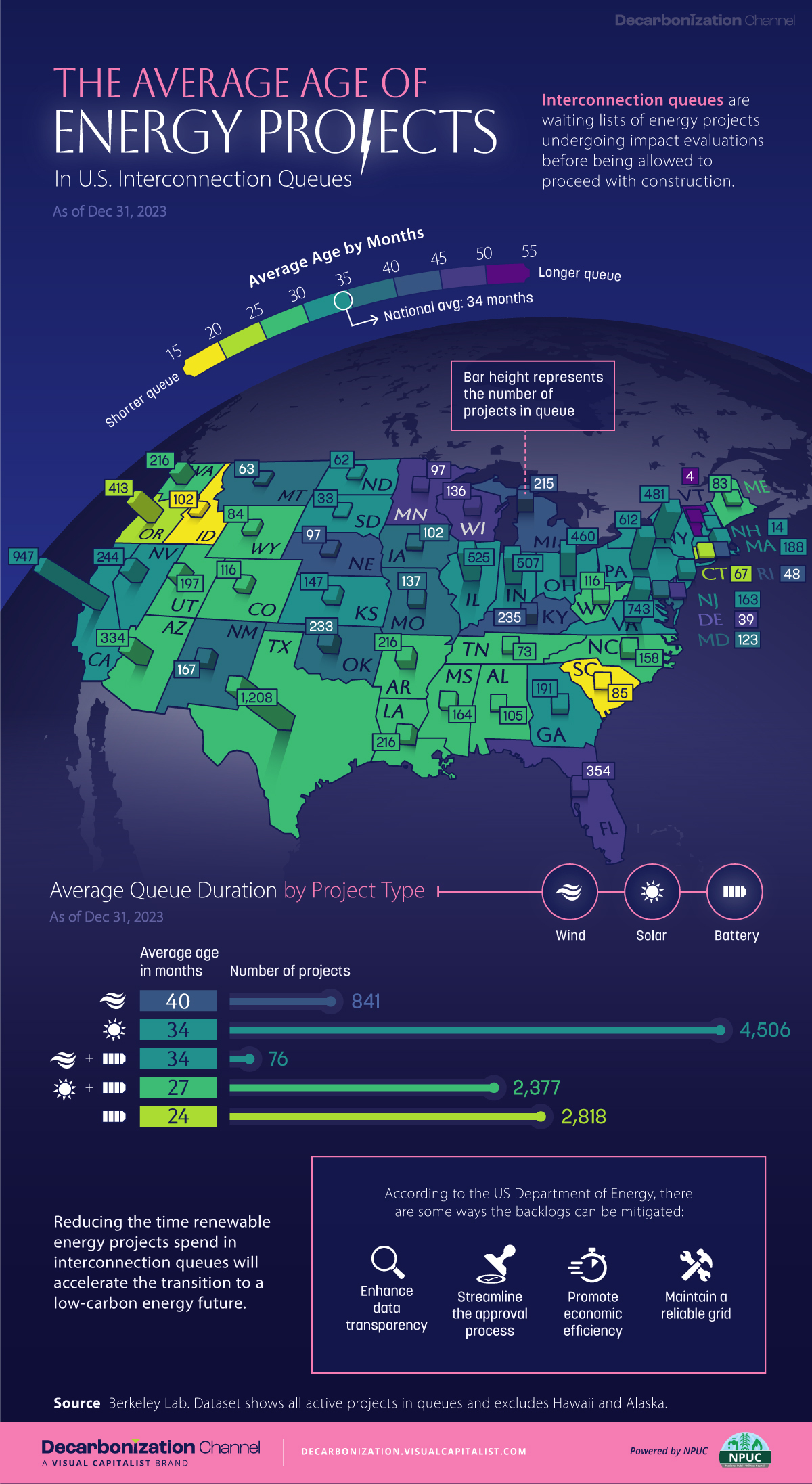Energy
What Electricity Sources Power the World?
![]() Subscribe to the Elements free mailing list for more like this
Subscribe to the Elements free mailing list for more like this

What Powered the World in 2022?
This was originally posted on Elements. Sign up to the free mailing list to get beautiful visualizations on real assets and resource megatrends each week.
In 2022, 29,165.2 terawatt hours (TWh) of electricity was generated around the world, an increase of 2.3% from the previous year.
In this visualization, we look at data from the latest Statistical Review of World Energy, and ask what powered the world in 2022.
Coal is Still King
Coal still leads the charge when it comes to electricity, representing 35.4% of global power generation in 2022, followed by natural gas at 22.7%, and hydroelectric at 14.9%.

Source: Energy Institute
Over three-quarters of the world’s total coal-generated electricity is consumed in just three countries. China is the top user of coal, making up 53.3% of global coal demand, followed by India at 13.6%, and the U.S. at 8.9%.
Burning coal—for electricity, as well as metallurgy and cement production—is the world’s single largest source of CO2 emissions. Nevertheless, its use in electricity generation has actually grown 91.2% since 1997, the year when the first global climate agreement was signed in Kyoto, Japan.
Renewables on the Rise
However, even as non-renewables enjoy their time in the sun, their days could be numbered.
In 2022, renewables, such as wind, solar, and geothermal, represented 14.4% of total electricity generation with an extraordinary annual growth rate of 14.7%, driven by big gains in solar and wind. Non-renewables, by contrast, only managed an anemic 0.4%.
The authors of the Statistical Review do not include hydroelectric in their renewable calculations, even though many others, including the International Energy Agency, consider it a “well-established renewable power technology.”
With hydroelectric moved into the renewable column, together they accounted for over 29.3% of all electricity generated in 2022, with an annual growth rate of 7.4%.
France’s Nuclear Horrible Year
Another big mover in this year’s report was nuclear energy.
In addition to disruptions at the Zaporizhzhia nuclear power plant in Ukraine, shutdowns in France’s nuclear fleet to address corrosion found in the safety injection systems of four reactors led to a 4% drop in global use, year-over-year.
The amount of electricity generated by nuclear energy in that country dropped 22% to 294.7 TWh in 2022. As a result, France went from being the world’s biggest exporter of electricity, to a net importer.
Powering the Future
Turning mechanical energy into electrical energy is a relatively straightforward process. Modern power plants are engineering marvels, to be sure, but they still work on the same principle as the very first generator invented by Michael Faraday in 1831.
But how you get the mechanical energy is where things get complicated: coal powered the first industrial revolution, but heated the planet in the process; wind is free and clean, but is unreliable; and nuclear fission reliably generates emission-free electricity, but also creates radioactive waste.
With temperature records being set around the world in the summer, resolving these tensions isn’t just academic and next year’s report could be a crucial test of the world’s commitment to a clean energy future.
Energy
Mapped: The Age of Energy Projects in Interconnection Queues, by State
This map shows how many energy projects are in interconnection queues by state and how long these projects have been queued up, on average.

Age of Energy Projects in Interconnection Queues, by State
This was originally posted on our Voronoi app. Download the app for free on iOS or Android and discover incredible data-driven charts from a variety of trusted sources.
By the end of 2023, more than 11,000 energy projects were in interconnection queues in the United States, waiting for a green-light from regional grid operators to proceed with construction.
This map, created in partnership with the National Public Utilities Council, maps out the average age of active energy projects in interconnection queues by state, using data from Berkeley Lab.
Interconnection Queues, Explained
Interconnection queues are lists of energy projects that have made interconnection requests to their regional grid operators. Once submitted, these requests formally initiate the impact study process that each project goes through before grid connection, forming waiting lists for approval known as interconnection queues.
In recent years, both the number and generation capacity of queued projects have surged in the United States, along with the length of time spent in queue.
According to Berkeley Lab, the amount of generation capacity entering queues each year has risen by more than 550% from 2015 to 2023, with average queue duration rising from 3 years to 5 years the same period.
As a result of the growing backlog, a large proportion of projects ultimately withdraw from queues, leading to only 19% of applications reaching commercial operations.
The Backlog: Number of Projects and Average Wait Times
Of the 11,000 active projects in U.S. queues at the end of 2023, Texas, California, and Virginia had the most in queue; 1,208, 947, and 743, respectively.
When looking at the average ages of these projects, all three states hovered around the national average of 34 months (2.83 years), with Texas sporting 28 months, California 33, and Virginia 34.
Vermont, Minnesota, Wisconsin, and Florida, on the other hand, had the highest average queue durations; 54, 49, 47, and 46 months, respectively.
Average Queue Duration by Project Type
At the end of 2023, more than 95% of the generation capacity in active interconnection queues was for emission-free resources. The table below provides a breakdown.
| Project Type | Average Queue Duration (As of 12/31/2023) | Number of Projects in Queue |
|---|---|---|
| Wind | 40 months | 841 |
| Solar | 34 months | 4,506 |
| Wind+Battery | 34 months | 76 |
| Solar+Battery | 27 months | 2,377 |
| Battery | 24 months | 2,818 |
Wind projects had the highest wait times at the end of 2023 with an average age of 40 months (3.33 years). Solar projects, on the other hand, made up more than 40% of projects in queue.
Overall, reducing the time that these renewable energy projects spend in queues can accelerate the transition to a low-carbon energy future.
According to the U.S. Department of Energy, enhancing data transparency, streamlining approval processes, promoting economic efficiency, and maintaining a reliable grid are some of the ways this growing backlog can be mitigated.
-

 Culture7 days ago
Culture7 days agoThe World’s Top Media Franchises by All-Time Revenue
-

 Science2 weeks ago
Science2 weeks agoVisualizing the Average Lifespans of Mammals
-

 Brands2 weeks ago
Brands2 weeks agoHow Tech Logos Have Evolved Over Time
-

 Energy2 weeks ago
Energy2 weeks agoRanked: The Top 10 EV Battery Manufacturers in 2023
-

 Demographics2 weeks ago
Demographics2 weeks agoCountries With the Largest Happiness Gains Since 2010
-

 VC+2 weeks ago
VC+2 weeks agoVC+: Get Our Key Takeaways From the IMF’s World Economic Outlook
-

 Demographics2 weeks ago
Demographics2 weeks agoThe Countries That Have Become Sadder Since 2010
-

 Money1 week ago
Money1 week agoCharted: Who Has Savings in This Economy?

 Can I share this graphic?
Can I share this graphic? When do I need a license?
When do I need a license? Interested in this piece?
Interested in this piece?








